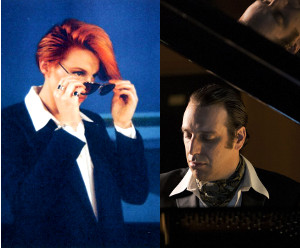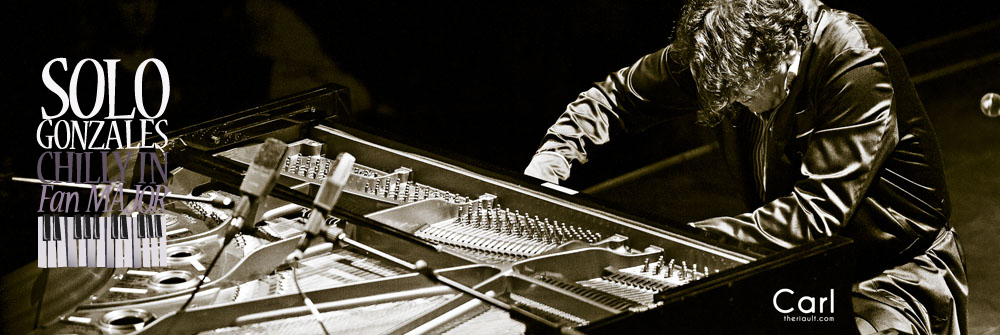 Gonzales is certainly a sought-after Grammy-award winning composer, producer, collaborator, and guest musician. It is within this latter role that he performs on La Roux’s latest release, “Trouble in Paradise”. Gonzales plays on two tracks: “Kiss and Not Tell”, and “Paradise is You”. We’re generally used to Gonzales’ piano playing being pretty much front-and-centre, which makes these tracks an interesting listen. Guest musicians are expected to contribute their unique musical style to a piece, while still retaining the “core elements” of the main artists’ song. In both of the tracks, you can certainly hear Gonzales’ performance, but his playing reinforces the song, rather than overshadowing it. It’s worthwhile to have a closer examination of each track to see what extra elements Gonzales brings to these songs. Both songs are available for preview through your ‘localized’ iTunes or Amazon store.
Gonzales is certainly a sought-after Grammy-award winning composer, producer, collaborator, and guest musician. It is within this latter role that he performs on La Roux’s latest release, “Trouble in Paradise”. Gonzales plays on two tracks: “Kiss and Not Tell”, and “Paradise is You”. We’re generally used to Gonzales’ piano playing being pretty much front-and-centre, which makes these tracks an interesting listen. Guest musicians are expected to contribute their unique musical style to a piece, while still retaining the “core elements” of the main artists’ song. In both of the tracks, you can certainly hear Gonzales’ performance, but his playing reinforces the song, rather than overshadowing it. It’s worthwhile to have a closer examination of each track to see what extra elements Gonzales brings to these songs. Both songs are available for preview through your ‘localized’ iTunes or Amazon store.
Kiss and Not Tell
On this track, Gonzales is credited with piano (no surprise), and Hammond organ. Somewhat reminiscent of “Working Together”, a slightly processed piano (or synth) motif kicks off the song straight away, and is very catchy with glissandos and rolled chords. After the chorus is repeated, one expects the piano motif to return, but it’s replaced by muted guitar strumming, allowing the listener to ‘fill in’ the missing motif, thus reinforcing it. The Hammond organ (apparent during the chorus) provides a nice ambiance and fills in the soundspace nicely with slight tension and resolution. Halfway through the song, the breakdown includes descending piano tones, and a processed guitar that somewhat mimics the piano. In the background there are also some ‘wandering’ lower register chords that reinforce the other songs and instruments. The end of the song is pretty much a cut with some resonating sounds that fade away.
There are certainly multiple layers of piano (processed and ‘natural’) and Hammond organ on the song – there aren’t many parts that would be considered “quiet”. Overall, a very bouncy melody with two main piano ‘layers’ – the main motif plus the underlying chords and wandering notes.
Paradise is You
This track starts with soft ‘industrial’ street noise that continues throughout the song, quickly overshadowed with Elly’s lovely tones accompanied by Gonzales’ piano chords. The intro definitely sets the mood for the song, with no real modulation of the main chords, but at just over a minute, the mood of the song is shifted to a more optimistic tone, along with slowly arpeggiated tones. A piano breakdown ensues, which seems to underscore the main theme the song. At one point, it’s just drums, vocal and piano, which leads into a bar of solo piano, which is quickly accompanied by a string synth soundscape. Overall, lovely melancholy chords, harmonies, and arpeggios, with a soft breakdown. The song ends with the same industrial “street” noise that it started with – as if someone was wandering along a street, had this song pop into their head (an image of paradise with someone they love), only to return to the cold reality of the street. Gonzales has indicated this in the past: Songs can be short fantasies that take you to a different place for a few moments, and this song definitely falls into that category. The piano accompaniment goes a long way in supporting a “flight of fancy”.
The credits for the song also list Gonzales on “vibes” or vibraphone, which Gonzales “considered” after learning drumming, and called it the, “nerdiest instrument ever invented…it’s very difficult to get your body involved with it.” It’s difficult to hear the vibes in their own right on the song, but instead, they are used to shape the sound of the piano at certain points, adding warmth and sustain. Gonzales played vibes in combination with piano very effectively in Feist’s “The Water”, but here, the vibes take on more of a supporting role.
Gonzales contribution to both tracks underscore how an experienced and talented musician can take a song to the ‘next level’ with a host of techniques that listeners wouldn’t only explicitly ‘hear’, but also ‘feel’. There’s no question that Gonzales receives a multitude of guest keyboard requests, but he’s expressed his desire to concentrate mainly on his own music, which is why each contribution is special. The connection to “La Roux” may have been a request though Cherrytree Records – the label that Feist and La Roux record under, or Gonzales may have received a request from Elly personally – there isn’t any obvious link as to how Gonzales ended up adding his ‘touch’ to these songs, but the resulting songs are very compelling (especially for fans of Gonzales).
